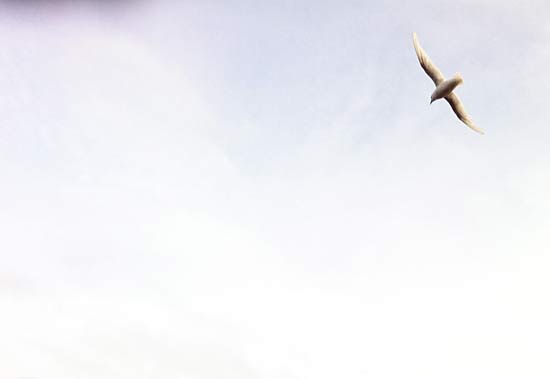The Whitest Seabird
Text and photos by Hugh Powell February 19, 2011

Snow Petrels kept our ship company in the Ross Sea and sometimes landed on the bow. 

As this one crosses the bow, you can see our orange hull reflected in its white feathers. 

Snow Petrels meet the fiercest winds with outstretched wings, turning it to their advantage. 

In higher winds they weaved across the waves, resting in the wind shadow of our bow. 

Sometimes one came to rest for a few minutes on hard surfaces like the ship's crane tower. 

A Snow Petrel floats out of the lee of our bow, heading into the wind with a shudder. 

Up close, you can see how delicate these small birds are. 

In fine weather they soared far above the ship, stretching narrow wings across the sky. 

They were undeterred by weather of any kind, and seemed at home in snowstorms. 

Sometimes they were just part of the scenery, like dots under a sunlit cloud.
You could argue a case for the Ivory Gull, but as far as immaculate whiteness goes, I adore the Snow Petrel. Made all the whiter by its big black eye, black bill, and black feet, this is a bird that belongs in front of icebergs, coursing on the cold black waves of gales.
In big seas, the waves hide rafts of hundreds. They sit there on calm scraps of water amid the rollers and spray, ducking their heads after prey such as krill. Or they just rest and preen, bills tossing water over their backs, wings making small alternating flutters in the washing motions that all birds share. Never mind that the snow is falling horizontally above them and the water surface shifting and tilting around them. They’re at home.
I’m back on land now, though still in Antarctica (waiting for clear weather to fly out). In my month at sea, Snow Petrels were my most familiar companions. These are truly polar seabirds—they occur only as far north as the pack ice of the Southern Ocean, and they nest on cliffs on the Antarctic continent and islands.
They’re common in the Ross Sea. In our 24-hour daylight, I could look out my porthole anytime and have an even chance of seeing two or three white birds dodging waves at eye level, catching up and passing us with scarcely a wingbeat—just minor modifications to the shape of their scimitar wings.
I took to drinking morning coffee on the top deck and watching them play in the eddies that streamed off the ship’s superstructure. A rotation of Snow and Antarctic Petrels would gain on us, sighting on the ship’s smokestack, then drifting up to within a wing’s reach of the loading crane, then on up to the bridge wing (used by the ice pilot to sight his way through thick floes). Once they reached the full wind of the bow they canted their narrow sails 30 degrees to starboard and spun into our wake again, to start the glide back up.
But the best views were when the winds came up and the skies darkened to pearl gray. The cold Ross Sea is the color of obsidian, and Snow Petrels darting about the waves look like whitecaps come to life. In soft light they lose their whiteness and take on the grays and near-blacks of snowfall at twilight. Their wings seem never in motion, but always at work, as they range far off our beam, coast back, and hang for an instant on the plume of air ribboning off the starboard rail. If I stood there long enough, I could get a few close-ups even on my iPhone. So what do you think? The whitest seabird?
See more photos at our expedition site.


All About Birds is a free resource
Available for everyone,
funded by donors like you




